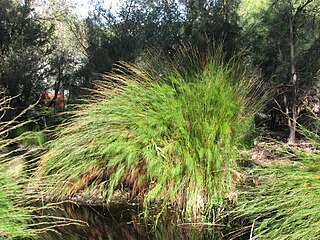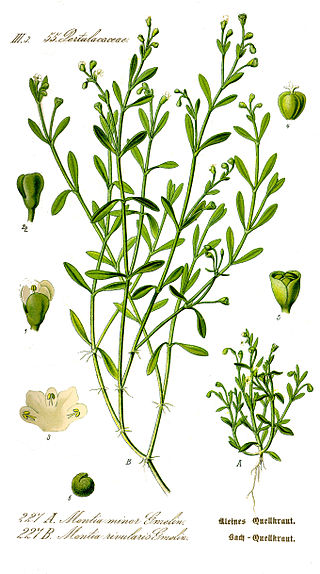
Caryophyllaceae, commonly called the pink family or carnation family, is a family of flowering plants. It is included in the dicotyledon order Caryophyllales in the APG III system, alongside 33 other families, including Amaranthaceae, Cactaceae, and Polygonaceae. It is a large family, with 81 genera and about 2,625 known species.
British NVC community MC5 is one of the maritime cliff communities in the British National Vegetation Classification system. It is one of five communities categorised as maritime cliff crevice and ledge communities.

Cryptosepalum is a genus of flowering plants in the family Fabaceae. There are 12 species, mostly trees. They are native to sub-Saharan Africa, ranging from Guinea to Tanzania, Mozambique, and Angola.
Cryptosepalum tetraphyllum is a species of plant in the family Fabaceae. It is found in Ivory Coast, Ghana, Guinea, Liberia, and Sierra Leone. It is threatened by habitat loss.

Polycarpon tetraphyllum, commonly known as four-leaved allseed, is a plant of the family Caryophyllaceae. An annual herb growing to 15 cm in height, it is found on sandy soils, in coastal areas and on wasteland. Native to Europe, it is also naturalised in parts of North America, Australia and elsewhere. It is rare in Britain, except in the Scilly Isles.

Pigeon Island is a small island located need the middle of the Wallabi Group of the Houtman Abrolhos, an archipelago off the coast of Western Australia. It is almost entirely given over to western rock lobster fishers' camps, and as a result is far more disturbed than most other islands in the archipelago. A nearby island also seasonally populated by fishers is named Little Pigeon Island, hence Pigeon Island is sometimes referred to as "Big Pigeon Island".
John Earle Raven was an English classical scholar, notable for his work on pre-Socratic philosophy, and amateur botanist.

Tripodion tetraphyllum is a species of flowering plant in the legume family, Fabaceae. It is an annual herb, commonly known as annual kidney vetch, native to the Mediterranean Basin of southern Europe, North Africa, and western Asia. It grows in the Mediterranean–Sahara transition zone of North Africa, and in anthropic landscapes. It is the sole species in genus Tripodion, which belongs to subfamily Faboideae.
Polycarpon depressum is a species of flowering plant in the family Caryophyllaceae known by the common name California manyseed. It is native to southern California and Baja California, where it grows in sandy habitat such as coastal bluffs and disturbed habitat types such as fields and roadsides. It is a small annual herb producing a spreading, branching stem just a few centimeters long that lies prostrate on the ground. A few pairs of oppositely arranged leaves line the stems, each oval in shape narrowing to a petiole and measuring about a centimeter long. The inflorescence is a cluster of rounded flowers with minute petals tucked inside a calyx of pointed sepals.

The 10th edition of Systema Naturae is a book written by Swedish naturalist Carl Linnaeus and published in two volumes in 1758 and 1759, which marks the starting point of zoological nomenclature. In it, Linnaeus introduced binomial nomenclature for animals, something he had already done for plants in his 1753 publication of Species Plantarum.
Adiantum vivesii is a rare species of maidenhair fern known by the common name Puerto Rico maidenhair.

Caerthillian to Kennack is a coastal Site of Special Scientific Interest (SSSI) on the Lizard Peninsula in Cornwall, UK, noted for both its biological and geological characteristics. It is of great botanical importance, with several Red Data Book of rare and endangered plant species being found on the site, as well as a breeding site for Cornish choughs.

Baloskion tetraphyllum is a rush-like plant in the family Restionaceae. Common names include tassel rope-rush, plume rush and Australian reed.

Lipandra polysperma, common name manyseed goosefoot, is the only species of the monotypic plant genus Lipandra from the subfamily Chenopodioideae of the family Amaranthaceae.

Saurosphargidae is an extinct family of marine reptiles known from the Early Triassic and early Middle Triassic of Europe and China.

The Didymocarpoideae are a subfamily of plants in the family Gesneriaceae. It was formerly the subfamily Cyrtandroideae. This subfamily consists mostly of tropical and subtropical Old World genera, found in Africa, Asia and the Pacific. One species is native to Central and South America.
Tetraphyllum is a genus of flowering plants belonging to the family Gesneriaceae. As of April 2021, there was no consensus as to whether the correct scientific name for the genus is Tetraphyllum or Tetraphylloides, some sources using the former and some the latter.

Polycarpon polycarpoides is a species of flowering plant in the manyseed genus Polycarpon, family Caryophyllaceae, native to the western Mediterranean; Morocco, Algeria, Tunisia, Spain, the Balearic Islands, France, Italy, and Sicily. It is a member of the Polycarpon tetraphyllum species aggregate.
Polycarpon alsinifolium, the fourleaf manyseed, is a species of biennial herb in the family Caryophyllaceae (carpetweeds).












